Seen above, the bright morning was invigorating, and a cool breeze rustled the curtains of our quiet hotel room. After showering, the first thing that we wanted to do was start our day atop horses, riding through the park. Delightfully, people can ride horses in the bustling capital! You can't do that in New York City. Lewis and I enjoyed the short walk past the towering Royal Lancaster London Hotel to a hidden treasure in the mist of the metropolis: a stable full of horses. It is located on a street named Bathurst Mews, which is named for the mews that existed there. A mews is a series of stables that include living accommodations above them. A third of central London's streets were originally mews that housed horses, coaches, carriages, and stableboys... for the stately homes on the main streets. Looking at a map of London, you’ll see dozens of street names that are duplicated for their mews: e.g. “Bathurst Street and Bathurst Mews” or "Charlotte Street and Charlotte Mews". Due to London's architectural preservation, the mews retain cozily-historic buildings—and they are highly-sought-after as handsome apartments.
Two active stables remain in the city-center, and both exist in a triangle of land named the Hyde Park Estate. Those 90 acres are privately owned by the Church of England. Yes, the church is the landlord. Such an arrangement harkens back the medieval era when the Roman Catholic Church (often the official religion of European nations) owned swathes of property with tenants. Some clergy were prince-bishops who were sovereigns of their own realms.
Thankfully, with a traditional-minded landlord in charge, the area succeeds at having riding stables for public use—something that is missing in many other capitals. Perhaps having a landlord that values historic heritage enables horses to cleanly coexist with the modern populous.
*To see when we explored urban land owned by a church in Manhattan, please use this link...
https://halfwindsorfullthrottle.blogspot.com/2017/06/walking-tour-english-village-scenery-in.html
Horseback riding provides a wonderful "escape" and a refreshing connection with Nature. Lewis and I are animal lovers, and Lewis' Chinese zodiac sign is the horse. Aside from pony rides at kiddie farms, the only time that he and I were astride horses was in the Caribbean. To see that horseback riding excursion, please use this link:
https://halfwindsorfullthrottle.blogspot.com/2017/10/dominican-republic-vacation.html
From my online research, I knew that the Ross Nye Stables were shuttered for the summer whilst its horses summered in the countryside. But our first choice was Hyde Park Stables, which remained open. It's a larger enterprise with more horses; some rotate for two months in the countryside whilst others provide joy to city dwellers. From 9am to 3pm, they offer semi-private lessons and rides through the park for £115 each, per hour.
Sandwiched between Sussex Gardens and Sussex Square...
...the stables are only three blocks from Paddington Station! That’s convenient for people who come to the capital for their riding lessons and then return home. How many other cities have infrastructure that allows you to do that? That is so cool!
From our hotel, we used a pedestrian alley named Elms Mews. Then, we crossed Gloucester Terrace, Lancaster Terrace, and arrived at the stables. The scene was picturesque.
While we waited, we admired the handsome horses and our spiffy surroundings. The cobblestone lane was freshly-hosed, and its stones glinted in the sunshine. It's a residential lane, and the stables are clean: no odor offends the residents.
Compare that to the disgusting stench from NYC's neglected horse-carriage stables at Clinton Park, which can be smelled from 5 streets away and causes outrage by animal-loving citizens. The unclean horses are compelled to pull grimy carriages in Central Park, and their owners are repeatedly berated by the public because their horses look miserable and malnourished, and their stench (at Fifth Avenue) can be smelled all the way on Madison Avenue! Use this link to read about it:
https://halfwindsorfullthrottle.blogspot.com/2016/01/a-ban-on-central-park-horse-carriages.html
Hyde Park Stables has several horses of various ages and heights. All have gentle temperaments and enjoy being petted. Lewis was designated to ride one named Splash, and we saw him munching on hay. My steed was named George, and he was the second-tallest gelding. (A castrated stallion is called a gelding). All the horses were freshly-scrubbed, brushed, covered with saddle cloths, and they were saddled. Their manes were nicely-trimmed. The Tack Room was full of professional equipment, and the knowledgeable staff maintained things.
The bearded man behind the counter asked if we ever rode horses in Manhattan? We hadn't. People can't do that in NYC: America's wealthiest city. The only place that offered horse rides in Central Park operated for 27 years inside a building that was condemned as a safety hazard. The gluttonous city allowed the park's bridle paths to deteriorate, which made horseback riding impossible. So, NYC's only riding stable closed in 2007, and—uncaringly—no civic effort was done to save it. For the next four years, the only option existed 10 miles north, in the neighboring Bronx County—and it had extremely limited availability—making it nearly impossible for most people to have access. By 2011, all options were gone.
We were delighted that we had a private ride with our own instructor, as opposed to being in a group led by one. Two other couples arrived for their own instructors. Accompanied by his fiancée, one customer was an Army captain who never rode before. Two young women had moderate experience and intended to gallop. As beginners, Lewis and I were content for a "gentle walk" through the park—as a smiley staffer described it. A dark-skinned woman gave us riding boots, while an Asian girl fitted us with riding helmets.
Our instructor introduced himself. His name was Ryan, and he started riding when he was four-years-old. Now, he is a senior-level instructor. His boyfriend works for Gucci, so he immediately appreciated Lewis' dazzling career at Chanel. He fetched his 14-year-old mare, named Cilla. We watched the youthful employees jockeying for space as they brought out our horses and got them into formation. Red plastic steps were used to help us get mounted. Lewis was up in the saddle “in a twinkling”; he was so excited. Once astride, we quickly became fond of our horses. They weren't restless, and they enjoyed it when we patted their necks and stroked their fur. The cheery Asian girl adjusted our stirrups to match the lengths of our legs.
With Ryan leading the way, we let out the reins and urged our horses forward. Our trio clip-clopped along the cobblestones.
Holding the reins, we followed Ryan through the gateway and out onto the public streets. As a safeguard, he gripped ropes that connected to our horses.
From Bathurst Street, we veered left onto Westbourne Street.
It was exciting to ride the horses through London's streets; the clip-clop sounds ricocheted off the historic townhouses, and cyclists and motorists politely let us pass before them.
Ryan advised us to steer our horses—whenever possible—within the "horse riding lanes" on the streets. Yes, that area of London has horse lanes!
As a truly first-world metropolis, London also has designated bike lanes. We wish those existed in America, which needs to rid itself of more traffic congestion than the UK.
To lure people, NYC falsely claims to have bike lanes, but most look like this...
In London, horse riders exchange courtesies with everyone.
We mimicked Ryan's polite gesture of pinching the visor of his hat; it was the mannerly equivalent to tipping his hat as a salutation—or a form of thanks—to other people.
Seen during my visit to Texas, cowboys use that gesture, too.
It's a "break in monotony" for Londoners to see horses on the road, and London's traffic is calmer than in America: rarely do people honk their horns, drivers are patient, drivers aren't aggressive, and few people blast their car stereos (unless on a Friday night). Thus, the horses were unruffled by the vehicles.
Just like everybody else, we waited at a red traffic light. Then, the horses' hooves crossed a busy thoroughfare named Bayswater Road. People in double-decker buses waved at us, and one motorcyclist gave a "thumbs-up" sign. Ryan explained his relief that the motorcyclist didn't rev his engine, which might dismay the horses. Our trio proceeded nonchalantly along Bayswater Road, as Black Cabs and Royal Mail vans zoomed by.
We were on the north border of Hyde Park, and we approached Victoria Gate (named for Queen Victoria), which is the vehicular entrance to the park. Last autumn, Lewis and I used Albert Gate (named for Victoria’s husband), which is a southern entrance to Hyde Park from Knightsbridge.
Soon, we steered our horses through bollards that kept vehicles off the paths within the 350-acre royal park.
Each bollard was marked with the Royal Cypher (monogram of the monarch).
Hyde Park is a woodland oasis in the capital. Horse hooves crunched over fallen leaves, and we felt immersed in a sanctuary. Brits adore Hyde Park, and it has a special history. During the Tudor dynasty, King Henry VIII usually seized whatever he wanted without payment. But to gain Hyde Park, he exchanged land with the monks of Westminster Abbey in 1537. Three years later, the monastery was surrendered to the Crown, and the abbey was repurposed as a cathedral. Ergo, a huge stretch of land from Whitehall to Kensington Gardens became the personal possession of the monarch. It remained that way, and when the Crown Estate was devised in 1760, the green-space was preserved.
For more than five centuries, Hyde Park has been a world-renown place for equestrian fun. It's the most beautiful setting in a capital city anywhere in the world. Forming loops, its riding trails traverse 2.5 miles. The oldest ones were created during the reign of King Charles I, in the 1620s.
Thanks to royal conservation in the urban landscape, they retain their bucolic appearance.
We rode past Buckhill Lodge, circa 1858, once inhabited by caretakers. Its "gingerbread" woodwork was ornate. The park has several lodges; some were guardhouses. Since 2012, the Royal Parks rents them as quaint getaways in a rural setting.
Several minutes later, our horses took us past an Allotment Garden.
*Use this link to see our county's only Community Garden:
https://halfwindsorfullthrottle.blogspot.com/2020/10/community-garden-we-never-knew-existed.html
Heading south, the bridle path ran parallel with West Carriage Drive: the only vehicular route through the park. We observed the modern-looking Serpentine North Gallery (named for the park's Serpentine Lake, which was manmade in 1730 by order of Queen Caroline).
It was fun to cross the Serpentine Bridge, a classic bow-bridge with five arches that was built in the 1820s. It was designed by Sir John Rennie, who famously constructed the newest version of London Bridge in 1824.
Ryan's horse was a "fancy prancer" and happily paraded for bystanders.
They were heading to one end of "Rotten Row", so they could turn around and charge forward. At 4,541-feet, Rotten Row is the widest path—and perfect for galloping.
In the mornings, it is used by the army's Household Cavalry, as well as mounted units of the Metropolitan Police Service. Since its inception, Rotten Row was meant for horses.
During our equine jaunt, we had lovely conversations with Ryan. He was flattered that we wanted to know about him, and he adored our affable American charm. Ryan described his many trips (the British say "holidays", instead of "vacations"). As compared to overworked Americans who receive the fewest weeks of vacation on Earth, Europeans get 5-6 weeks—even as new employees. It is part of Life/Work balance that most of civilized humanity understands. Ryan and his boyfriend make five trips per year; many are to Italy, where his boyfriend immigrated from. During his career, one of Ryan's jobs as a logistics engineer gave him 10 weeks of paid time-off! Meanwhile, it is standard in America for employees who are managers and below to only receive 2 weeks per year. Directors might get 3 weeks, as do employees who keep their jobs for 5+ years. (That's pathetic for a so-called "first-world" nation, yet America's uncaring government deliberately lacks any laws for companies to provide any vacation days, nor are there obligations to observe state-or-federal holidays as paid days off).
Recently, Ryan was hired by a tech start-up, but the company failed due to the pandemic. Nonetheless, the cost of living in England is more affordable than in the USA (and they have Universal Healthcare, which is not a deduction of their paychecks), so he and his boyfriend still live comfortably in London. For now, Ryan works full-time at the stables; he loves his job.
Our hotel's supreme location made it convent to traipse back, freshen up, change clothes, and walk 'round the corner for a freshly-made breakfast. Riding horses builds up an appetite.
We walked from Craven Terrace onto Craven Road. (They are named for The Earl of Craven who initially owned them. In North Carolina, Craven County is named for him, too). Lewis and I popped into a French cafe & deli named Laurents.
Immigrating from Bordeaux, France and Sicily, Italy, the married owners operate three locations in the capital. The one in the Paddington neighborhood has three rooms brimming with oven-fresh breads, cured meats, patisserie creations, farm-fresh fruit and veggies, groceries, wines, small-batch cheeses, and excellent coffee. Lewis and I are fond of French food, so it was easy to find options from their extensive menu. Having worked with French colleagues at Cartier, we also know the correct pronunciation of some things... and the staff liked that.
Under a blue sky, we ate outside at the cafe's sidewalk seating: rattan chairs that were evocative of French bistros.
We sat beside nicely-dressed Arab women who spoke Dutch. (We recognized the Netherlandish language from our online courses that we took with prior hopes of Lewis' job-transfer to Amsterdam. Alas, fluency of that barely-used language was eventually demanded, so he was denied). On the other end of the small terrace, two Greek men dunked cookies into their espresso (made with beans from Honduras in Central America). A young Englishman nibbled on a stuffed-squid salad and a perfectly-crusted sausage roll. Despite Londoners being so active, few of them spent their mealtimes captivated by laptops or mobile devices. Instead, they chatted, people-watched, and relaxed. Life/Work balance.
A cheery French woman delivered my £3.10 ($4.25) latte to our table. (Near our home, the same-sized latte costs $5.75, plus $1.00 extra for non-dairy milk, plus $1.00 extra for ice!) Whereas American baristas expect you to wait within earshot to retrieve your coffee when they call your name, British baristas invite you to have a seat (indoors our outdoors), and they bring your coffee to you—wherever you are. American baristas expect you to clean away your dirty dishes. UK ones have a mentality that you are the guest, so you leave your dishes, and they will clean them. Despite providing less service, American baristas expect gratuities of $1.00-2.00 per drink. The UK has a non-tipping culture; they do their jobs courteously because it is the correct behavior.
Seen above, our perfect breakfast commenced with Italian cantucci filled with perfectly-hued pistachio paste. The cute counter-boy was impressed that I knew what a cantuccio was. Outsiders call everything biscotti. We learned the correct terminology during our trip across Italy, earlier this year.
*Please use this link to read about it:
https://halfwindsorfullthrottle.blogspot.com/2022/03/our-trip-to-italy-part-1-of-7-milan.html
Lewis was content with a homemade £10.00 toasted Croque Monsieur with smoked ham, cheese, and mushrooms. We also shared a summery recipe of beet salad with sliced apples. I enjoyed a moist slice of orange polenta cake, topped with rose-flavored frosting.
We drank a £5.00 bottle of freshly-squeeze orange juice—made from four oranges.
Our outdoor meal was only four streets from Paddington Station—one of the busiest train stations in the UK—yet the area was calm and beautiful. That's because London's cycling network and effective public transit eliminates traffic congestion! Try eating outside near your local train station. Will it be serene or clean? In grossly overpriced NYC, this is the typical (noisy/smelly) scenery...
Other admirable fixtures throughout central London are the flowerpots hung from streetlights. They harmonize with a profusion of flowery window-boxes on many buildings.
Those people care about the appearances of their communities. In stark contrast, eating outdoors in NYC is plagued by piles of garbage because the city layers its pavement with trash. There is no "garbage containment". These are my photos from NYC's expensive SoHo area, yet it looks as trashy as a ghetto. People overpay for the "privilege" to eat their food near the trash. In summer, the smell is rancid.
Keeping neighborhoods beautiful and modern are testaments of London's successes. We loved every minute of it: small pleasures are truly wonderful.
We saved room in our tummies for a trademark recipe at the United Kingdom's preeminent food purveyor: Fortnum & Mason. Their flagship store is located in the prestigious St James's neighborhood on a famous street named Piccadilly.
Last year, we shopped at F&M for the first time, and we were eager to return. (In the interim, we ordered their goodies online, and carefully-packed parcels were shipped promptly). In business since 1707, the brand was awarded with Royal Warrants from The Queen and the Prince of Wales. When alive, the Queen Mother also conferred her Royal Warrant on the company. Throughout its esteemed history, it served twelve monarchs and won its first Royal Warrant in 1910.
Some locals dislike its priciness, but it's less costly and hugely better-valued than America's "gourmet grocers": Citarella, Eataly, Dean & Deluca, Eli's Market, Garden Gourmet, Balducci's, or Bristol Farms. At F&M, well-intentioned employees are attired in tailcoats. The entire store is elegant. Shopping there is dreamy: everything is as it should be.
The grandly-proportioned store has a stunning array of gourmet snacks, fine foods, organic sweets, and 181 carefully-sourced teas. It also sells home-goods, fragrances, stationary, Christmas ornaments, and iconic F&M hampers that are ideal gifts around the world.
Immediately, we descended the spiral staircase to partake of ready-made food in the lower level.
We admired their Game Pie: a hearty filling of flavorful partridge, pheasant, and wild pigeon—layered with richly-made pastry. Intended to be served cold, a pie that served six people was only priced at £9.95. That's value!
F&M invented the Scotch Egg, which we enjoy very much: a hardboiled egg wrapped in sausage and coated with breadcrumbs. Whereas the USA suffers from global criticism of its hormone-injected, factory-made eggs, the UK instills quality assurance on its eggs.
In addition to the classic version, we selected a truffle flavor and one made with streaky bacon (made from pork belly). The attendant warmed them in the oven, and our first forkfuls released delectably-runny egg yolks.
As you can see, the ochre-colored yolks prove that healthy chickens made them.
We wanted foie gras pre-packaged in a tin, so we could bring it home, but they don't sell that type of item. We remained satisfied with our other purchases: boxes and tins of British-made cookies (Brits refer to them as biscuits).
In lieu of the elevators, we ascended the handmade—and historic—wood staircase...
We browsed through other levels but were drawn to the fragrance section. Bright and airy, it was bedecked with blooms.
A knowledgeable saleswoman from Austria guided us to find a fragrance that resonated with each of us. After much deliberation (as seen in this photo)...
...Lewis decided on Gdańsk, created by Gallivant. Unbeknownst to us, the perfumer's slogan is "Fragrance for urban explorers". That's us! Evidently, the sales associate evaluated us accurately. (That's normal at Fortnum & Mason). Despite having hundreds of bottles surrounding her, she memorized the distinct "aroma notes" of each. Each bottle was priced at £65.
We recommend Gallivant, which is an independent company founded in London by Nick Steward, who has 20-years experience in London and Paris. "Bored by the posturing of many brands, he pioneered a way back to basics". Handmade in the UK, its unisex (gender neutral) scents are named for notable places around the globe that evoke their aromas. Each one is made ethically (and cruelty-free) in small batches—not overproduced in huge vats—and the creators are familiar with everyone in the supply chain. The essential oils come from Grasse, France (where Chanel grows its lavender). It's mixed with non-synthetic alcohol in the Cotswolds of England, and the packaging comes from a family-run enterprise in Kent.
Gdańsk is a port-city in Poland. The fragrance involves plum, honey, nutmeg, saffron, leather, sandalwood (sustainable from New Caledonia), patchouli, earth, and ambergris (found on seashores and made by sperm whales, but Gallivant uses a plant-based alternative). It matches the strong yet warm nature of that seafaring population, which is known for its tanneries.
The fragrance named London appealed to me. Every time I smell it, I remember our horse ride through Hyde Park! That's due to its aroma of "wet gardens" and lush earthiness. Ingredients include violet leaves, rose oil, orris root, cedarwood, and sandalwood. It was a finalist at the 2018 Art & Olfaction Awards.
Just like the brand's name, Lewis and I prefer to gallivant through places that make our hearts "sing"!
After our purchases, the store's antique clock (outside the main entrance) chimed the time and played a song, as its mechanical figurines paraded out of their bungalows and bowed to onlookers.
We knew that we needed to "dash" (as the Brits say) towards our next destination. We had reservations at one of the kingdom's most-coveted places for teatime.
Strolling north on Davies Street, we paused at the beautiful Berkeley Square, which we sat in, last year. It is serene. Created in 1789, its trees are among the oldest in Central London.
It once belonged to the 3rd Baron Berkeley of Stratton.
Farther north on the road, we visited the elegant Dunhill boutique.
Built in the 1720s, it is the only free-standing (the British say "detached") house in Mayfair. Rooms that were initially a dinning room, ante-dining room, drawing room, and library are now adorned with showcases and upscale merchandise. It sells everything from ready-to-wear attire and leather goods to eyewear and bespoke suiting. It has decanters of whiskey on each level. It contains a humidor, barbershop, and a gentleman's spa on the top floor. The Cellar Bar prepares drinks, luncheon, and cakes, and courtyard seating is available.
Lewis was curious to explore the interior because it was previously the London townhouse of the 2nd Duke of Westminster, named Hugh Grosvenor. In fact, since 1677, the Grosvenor family continues to own the Mayfair district. This is the family's coat of arms.
Mayfair's 279 acres, nine neighborhoods, and thousands of buildings, hotels, townhouses, mansions, and retail stores belong to the dukedom.
The ducal family also owns the Belgravia neighborhood. Aside from an area named Knightsbridge, those are the two wealthiest parts of the City of Westminster—and some of the most exclusive parts of England. Their property includes the only US Embassy in the world not owned by the USA. (The USA wanted to own its embassy but wouldn't agree to return the 12,000 acres it confiscated from the Grosvenors during the American Revolution).
After leasing the house for centuries, that duke moved into it in 1917 (his family gave their mammoth Grosvenor House to the government for WWI). The street is named for his ancestor's wife, Mary Davies, because the land was part of her dowry. In the late-1920s, His Grace (that's how you refer to a duke) gifted a building on that street to Gabrielle "Coco" Chanel as a symbol of his adoration. (It was just south of Claridge's Hotel). Using it as her atelier, Coco designed clothes for the Duchess of York: the future Queen and mother of the current Queen. Two streets west, Coco's home was at 9 South Audley Street. It was built in the 1730s, and it was also given by His Grace. The duke renovated it for her, and she dwelled there until 1934.
Everyone thinks of Coco's years in France, but she had a significant life in Britain, and her two favorite lovers were English (one was married). She and the duke became acquainted in the princely city of Monte Carlo in 1923, while she was having an affair with Russia's Grand Duke Dimitri. The English duke's ostentatious infatuation won Coco's affection, and it added him to her long list of affluent adorers/supporters. Twice divorced, His Grace sent footmen on trains to bring her flowers from his country estate. The pair spent several summers at his humungous estate in Scotland. He bought her a 12-bedroom mansion in the Scottish Highlands, named Rosehall. She was the chatelaine of his colossal Eaton Hall estate, where they partied with Winston Churchill and she befriended his son (which later helped her evade her pro-Nazi issues after WWII). The duke bought land for her on the French Riveira that had been owned by the Prince of Monaco. Coco created a villa that resembled her French orphanage (but every lavatory had a servant's entrance). Alas, the couple never married. Their affair ended in 1930, and the duke had two more wives. Coco's next lover died at the villa while playing tennis with her.
Consequently, an urban legend perpetuates that the Duke of Westminster influenced the City of Westminster to emblazon all of its lampposts with his scripted "W" and a pair of reversed, interlocking C's—that look like Chanel's corporate logo. The City Council repeatedly denies that. (It might seem embarrassing if they had been bamboozled by the duke).
That snippet of history was the perfect segue for our next destination, further up at the intersection of Davies Street and Brook Street. (Brook Street was named for the Tyburn Brook that it crossed).
Filling most of the block, Claridge’s stood before us.
With its main entrance on Brook Street, it is a gem of Art Deco elegance in Mayfair. As a rarity, Claridge's Hotel evaded being owned by the ducal family. It still bears the Grosvenor's coat of arms...
However, its current owners are the royal family of Qatar. Nevertheless, the dukedom still owns 4,300 of 4,500 properties on the land around the hotel.
The sun's rays made its redbrick façade look warmly-inviting. The windows sparkled, and the entranceway seemed to beckon us. The 5-star hotel provides Britain’s plushiest "red-carpet / white-glove" treatment. (Its website says that its lift (elevator) operator is the last in the capital). To be posh, we used the main entrance, where several flags dangled overhead. Fate arranged for the hotel to have an American flag on one of its flagpoles—indicating that the hotel hosted an American VIP. To be amusing (the British say "droll"), we considered the flag to be for us.
The hotel amazed us. Begun in 1812 by James Mivart, the hotel expanded into a neighboring property in 1817. By 1838, Mivart bought four more adjoining buildings.
During London’s Great Exhibition of 1851 (masterminded by Prince Albert), the hotel gained popularity from Russia’s Grand Duke Alexander Nikolaevich. (Side-note: he loved Queen Victoria in 1839 but their wedding was forbidden by his father, the czar. In 1855, he became Alexander II: Emperor of Russia, King of Poland, and Grand Duke of Finland, but he was assassinated in 1881. In 1874, his daughter married Victoria’s second son. Clearly, Fate intended those lovestruck dynasties to come together).
In 1854, the hotel was purchased by William and Mary Claridge, who were hoteliers at 49 Brook Street. Six years later, Queen Victoria and Prince Albert made a royal visit to rendezvous with Empress Eugenie of France, who stayed there for the winter. For 10 years, it was a favorite haven for Empress Elisabeth of Austria (who enjoyed an affair with a prominent English equestrian named George Bay Middleton—ancestor to Kate Middleton, the wife of Prince William). In 1893, the owner of London's Savoy Hotel bought it and commissioned C. W. Stephens—who designed Harrods Department Store—to entirely rebuild the hotel. That is the current building. During the "Roaring Twenties", parts of the huge hotel were redecorated by Oswald Milne—a forerunner of the Art Moderne style. Those 1920’s elements remain, and the tea room is one of them.
Outfitted in top hats and tailcoats, three doormen greeted us.
We entered via the revolving door—a mainstay of Art Deco hotels. As we emerged and crossed the glossy lobby, we traced the footsteps of countless celebrities. Everyone comes to Claridge’s—from the imperial family of Japan to Sheik Mujibur Rahman and Brad Pitt.
During WWII, the hotel miraculously escaped eight months of Nazi bombing and was nicknamed “the annex of Buckingham Palace” because of its many dignitaries, heads of state, and foreign royals who had appointments at the palace. During the war, the Nazis invaded most of Europe's nations, and London became the home of those governments-in-exile. The monarchs of the Netherlands, Norway, Greece, and Yugoslavia stayed at Claridge's, as did the Czech and Polish presidents. Prime Minister, Winston Churchill, extraordinarily declared that the room containing Yugoslavian royalty was “their native soil” so their crown-prince could be born in his native territory. (Now part of Serbian royalty, the prince cherishes that memory).
American spy-master, “Wild Bill” Donovan used it as his counterintelligence headquarters for the Office of Strategic Services (precursor to the CIA). He mustered nighttime meetings with Allied forces. From the entertainment industry, Alfred Hitchcock, Katharine Hepburn, Audrey Hepburn, Bing Crosby, Rita Hayworth, Yul Brynner, Truman Capote, Joan Collins, Mick Jagger, Julia Roberts, Kareena Kapoor Khan, and Kate Moss were guests.
Countless titans of industry, parliamentarians, and diplomats stay there. Hollywood actor, Spencer Tracy said, “I don’t want to go to heaven. I want to go to Claridge’s.” The current Prime Minister uses it for receptions, as did his 12 predecessors. In 1951, the first German chancellor to visit the UK since 1931 stayed there as an honored guest of the King. U.S. President Nixon stayed there in 1969, and Queen Elizabeth feted the Sultan of Oman in 1982. In 1986, the King and Queen of Greece hosted a double-birthday ball. The next year, Queen Elizabeth and Prince Philip celebrated their 40th (ruby) anniversary there. Their youngest son, the Earl of Wessex, began his honeymoon with a soirée there. This year, the hotel revived a cocktail from the Queen’s 1955 coronation, in celebration of Her Majesty’s Platinum Jubilee. Now, the hotel welcomed us, and its staff treated us equally.
Lewis and I noticed a line of three bellman who faced the entrance—ready to assist with anything. A bell-captain gave directions to each of them. The Front Desk was to our left, and we saw trollies of luggage being wheeled to elevators. At that moment, a Chinese bridal party crossed our path and posed on the grand staircase for photos.
Unfamiliar with the layout, we paused to find the Reading Room. A gentlemanly employee in a suit emerged from a room and greeted us. Unlike our experience at Amsterdam's Intnerconinetal Hotel—where the doorman tried to make sure that we "belonged in the right place"—the man merely asked if he could be of assistance. Hearing our question, he smiled grandly and gestured to the Reading Room, which was ahead of us. With a sincere smile, he wished us a pleasant afternoon. It was as if an uncle spoke to us.
Beyond the streamlined lobby, the Reading Room is where the hotel serves its world-famous Afternoon Tea. In 1998, it was restored by Thierry Despont. Coincidentally, Lewis and I witnessed his restoration work firsthand when he refurbished the Cartier Mansion on Fifth Avenue! (Both of us were hired—from thousands of candidates—to be in the Grand Opening team of 120 employees). Both of Despont's results are masterpieces of craftsmanship (although Cartier is still wastefully redoing everything, every year, at the Mansion).
Under a renown Chihuly glass creation, the Reading Room radiated genteelism.
Until 1990, servers wore red jackets and silk stockings with velvet breeches. Recently, the uniforms became white liveries. In our opinion, that blends better with the Art Moderne milieu.
Waiters moved with perfect posture, and tables were occupied by coiffed hairdos and handsomely-attired couples. Live music floated over the hubbub of the guests, and there is no cover-charge for it.
Unlike the overhyped Ritz Hotel, Claridge's does not have a dress code, and it serves a nicer Afternoon Tea. Compared to restaurants, you might suspect that hotels overcharge for food, but Claridge's provides excellent value.
At the Reading Room's podium, two hostesses wore scarves around their necks, and their makeup was perfect. They graciously paired guests with their preferred tables. The reservation was under my name, and the polite hostess made it a priority to discern if I should be addressed as "Mr." I was instantly reminded that I was in a realm with an aristocracy. She was dutifully trying to find out if I was a lord, earl, knight, or doctor. I confirmed that "Mister" was appropriate for Lewis and I. Realizing that we were a couple, her smile broadened and she guided us to our "table for two". It was in the middle of the room. Before seating us, she courteously asked if it was suitable. Being honest, Lewis expressed a preference for a table against a wall. That afternoon, at 3pm, the room was almost full. Nonetheless, the unflappable hostess asked if we desired a deuce in the side-room or in the main room? We accepted a deuce against the front wall of the main room. It was perfect.
Professionally, both hostesses held our chairs, so we could sit down. But we wanted to wash our hands, first. Graciously, we were directed to the Gentleman's Washroom, which is downstairs, via an Art Deco illuminated archway.
It's one of the finest washrooms that we know of. Splash-guards are placed at the bottom of the urinals, to protect your shoes from wayward drips. Antique sinks are complemented by bottles of luxuriously-foaming soap, and bottles of aromatic hand lotion. A tray was full of white cotton hand-towels, and we disposed of them in a hamper. The lavatory attendant stood outside; there was no "tip jar" in England's non-tipping society. Merely freshening myself in that room was akin to a brief spa experience.
The hostesses saw us returning and readied our chairs. Covered with crisp linen, our table had a silver lamp with fringed lampshade, gleaming silverware, and crystal stemware. Their trademark Limoges porcelain is patterned with alternating stripes of white and a vibrant jade "green". It honors tea's origins in China. Each iconic plate, cup, and saucer is handmade in France by Bernardaud, which was founded in 1863.
With glee, we promptly reviewed the lengthy menus.
Teas are impressive in Japan, Yemen, China, and India, but Afternoon Tea is a thoroughly English observance. It's part of the culinary heritage. For 150 years—despite wars and disasters—Claridge's provided one of the world's best rituals of it. Of course, the menu is seasonal. Unwaveringly, it includes a mouth-watering assortment of "finger sandwiches", oven-fresh scones, handmade pastries, and supreme-quality toppings. Loose-leaf teas are curated by The Rare Tea Company, which scours the world for the best ones—whether from ancestral plantations or small little-known producers. If you want rare Nepalese tea leaves from Himalayan altitudes or family-grown varieties from Africa, you contact that company.
Our waiter introduced himself as Mauritius. He was charming—as if serving us for hours was his sole priority. He set a languid tempo for our meal, which is how we like it. He inquired if we preferred the traditional menu—£75 per person—($86) or the one that was accompanied by champagne for £85 ($98). Lewis has a partiality for bubbly, so decided on that one. Mauritius bowed and retreated to the kitchens to convey our preferences to a team of specialists.
In 2013, the hotel ejected loudmouthed Chef Gordon Ramsey. Replacing his dramatics, an Estonian named Dmitri Magi became the Culinary Director, who worked with Chef René Redzepi at the world's best restaurant: Noma, in Copenhagen. *Please use this link to learn about it:
https://halfwindsorfullthrottle.blogspot.com/2019/05/a-better-way-to-treat-kitchen-staff.html
The executive chef is Richard Galli (lured from the Michelin-starred restaurant at London's Goring Hotel). The brilliant pastry chef is a Frenchman named Thibault Hauchard (lured from the Michelin-starred Alain Ducasse restaurant at London's Dorchester Hotel). Yes, we intended to sip tea in one of the world's best hotels, and we knew it would be worthy of Michelin stars!
Our eyes darted around the room. The interior is decorated with graceful geometric patterns. Basil Ionides helped design the Reading Room and several of the hotel's treasured guest rooms and suites. They retain those styles.
While piano music tinkled in the background, a white-jacketed server placed two champagne flutes on our tablecloth and poured full amounts of Laurent-Perrier La Cuvée Brut. Located in the Champagne region of France, the winery was founded in 1812.
Smelling of citrus, it's made of the purest grapes, obtained after a long aging. The bubbles fizzed, our server smiled, and our enjoyment increased. Wearing a well-tailored suit, the dining room captain came closer to oversee our satisfaction. The bottle-holding fellow withdrew, and Mauritius inquired if we wanted to savor the champagne alone... or with food. We know that it pairs with everything, so we asked him to bring some food. He understood that with a reverent bow of his head. He inquired, "Would you like me to serve tea?" Politely, Lewis stated that we preferred to sip the bubbly for awhile... and sip tea later. With the amusing diplomacy of characters from the BBC's "Jeeves & Wooster" series, he earnestly asked to take our order of tea(s) anyway, so the beverages could be prepped. Tea needs time to steep for full flavor. Our teacups and saucers were also warmed before being placed on our table: cold porcelain detracts from warm tea.
Earlier, we perused the website and knew that Claridge's is one of only two exclusive places in the world that serves a tree-tip tea named Malawi Antler, grown in Malawi, Africa. With its scarcity found only in a tiny patch of land in Satemwa at an elevation of 2,600-feet, it is one of the rarest teas. We like trying new things that are unique to the localities where we travel.
Instead of using leaves from the tea bush, the rare tea was made with the velvety stems of its springtime branches. (Just like tomato vines smell riper than tomatoes). Those "antlers" represented their terroir, and only a few kilos are produced, each year. (The tea-maker's website proudly boasts that "the tea is so extraordinarily good that it's served at Claridge's in London").
While the tea steeped, we discussed its practicality and flavor with Mauritius, who was delighted to have the conversation. Cushioning our expectations, he said that if we didn't like the tea, he would happily fetch us something else. Politely, I replied that we wouldn't want to waste a precious item that we invested in. That's when he clarified that Claridge's doesn't charge different prices for its teas. Just then, the captain overheard my remark and used aplomb to reveal that Claridge's doesn't add surcharges for its rare teas, nor does it charge you for each additional pot of tea. It graciously provides all of the teas on the menu for the price that you pay when you make the reservation. We could have as many teas as we desired. That is true luxury.
We were duly impressed. In America, greedy companies always charge customers surcharges and additional fees for anything extra and anything "special". We were so thankful to be investing our time in England, where excellence is provided without the outlandish greed!
The next windfall was when Mauritius presented our sandwiches. He explained that we could request more of any type—and we could have as many of them as we wanted. The kitchen would respond with unlimited sandwiches—like a First Class experience.
Consequently, that superb tea had a taste of earthy lychee and sun-dried apricot. We will remember it forever.
Mauritius informed us that the tea could be infused up to six times, and he offered us another pot. However, we were inclined to try different teas.
Whereas most places clutter your table with teapots and trays, Claridge's created custom-made stands that keep everything off the table. Standing on the carpet, they are table-height and hold the teapots, strainers, creamer, sugar-cube box, and platters of food.
Adding heavenly ambiance, a duo of musicians—cello and piano—performed a mix of traditional and contemporary songs. Their uptempo music was classy. Music has been performed at the hotel's eateries since 1902. Turn the sound on for Lewis' video of it...
To begin the first course of our meal, a food-runner presented a rectangular platter of finger-sandwiches.
One consisted of shrimp-butter on rye bread that was filled with smoked salmon from the Severn & Wye Smokery in Westbury-on-Severn. They comprehend the art of curing fish in an old-fashioned way. Rewardingly, they hold a Royal Warrant from the Queen as Purveyors to the Royal Court. Nobody is more excellent in Her Majesty's opinion. (Ironically, its website grieves about a lack of retail workers, yet Lewis is denied residency in the UK because his job is not at a management level. Foolish).
Another sandwich included Wexford pastrami with piquant horseradish cream on malt bread. The well-marbled meat came from grass-fed Hereford Angus cattle in Wexford county. The next one had Dorrington ham (made by a father and son in the West Midlands) with apple butter and Lollo Rosso lettuce on flavorful onion bread. After that, we tasted a white-bread sandwich that had organic duck egg mayonnaise (collected from Legbar Burford brown ducks in the Cotswolds and hand-cut at the hotel), baby watercress and chopped chives. As a classic, there was a sandwich of farm-fresh cucumber, mint, and lemon cream. Our favorite was the Chef's "Seasonal Savory": a cheese & onion tartlet with Welsh rarebit (it's not rabbit; it's a cheese sauce from the 1500s).
We really enjoyed them. As a busser cleared our table, our waiter offered to serve us more sandwiches. Indulging ourselves, we requested more of the tartlets, ham varieties, and pastrami ones. I savored another salmon one, too.
We drained our teacups with pleasure. Astutely, Mauritius noticed that it was time for more tea. He signaled a busser, attired in a black livery, who removed them with swiftness. New teacups and saucers were carried to us. With proper dignity given to the well-made teas, Mauritius announced that each choice was brewed to our preferred strengths... yet he kindly offered his recommendations. He also advised us that certain teas necessitated different temperatures of water and longer brewing times. We were already aware of those nuances. He seemed glad to be with tea-drinkers who valued the finer points of steeping tea. He mentioned that the menu included espresso and coffee, yet Lewis and I think that those drinks conflict with the notion of Afternoon Tea, so we bypassed them. Mauritius bowed to express his understanding. I think he wanted to wink at us with agreement.
For our next potful, Lewis craved a full-bodied herbal tea of lemongrass that was grown in the mountains of Sri Lanka (a Buddhist nation), near the Ravanna Waterfalls. At an altitude of 3,000-feet, the tender leaves are used, rather than the woody stems. It is harvested from small 100% organic growers across that tropical island-nation who focus on sustainability. Workers are paid overtime and given benefits, and their duties rotate through the entire circle of production. They also maintain a wildlife sanctuary.
At Claridge's, tea is not brewed by using tea-balls or teabags to encapsulate the lea leaves. The loose leaves are put in the teapot and water is poured over them. It allows them to unfurl. That is why the hotel's tearoom uses strainers, which keep the leaves out of your teacup when the tea is poured.
With a flourish, Mauritius lifted the striped teapot and served us. The tea's aroma was luscious. Its color was an ideal complement to the upcoming scones: bright and vibrant!
Deftly, a food runner presented a rectangular plate of four freshly-baked scones: two plain and two raisin. Their golden color hinted at their goodness. When we broke them open, the warmth from the oven was delightful!
First, let me differentiate between American things that are called scones... and real scones. This is what Americans are fed: an improper lump of thick dough that is dense and heavy.
If you like chewy biscuits, you'll be happy. But if you crave true scones, you won't find them. Moreover, they are often served as triangles, which is the wrong shape. At our home in Astoria—which is less costly than Manhattan—American versions of scones are overpriced at nearly $4.00 each. That's ridiculous, yet it coincides with America's agreeability to pay $5-6.00 for a cupcake. At Fortum & Mason—the priciest UK retailer—four mini scones only cost merely £1.00! At the superb grocer, Waitrose & Partners, four scones are priced at £2.00.
Greater quality at a lower cost. (Remember this pattern of truth: London is more cost-effective than American cities).
Here is my photo of Lewis daintily applying clotted cream on his scone.
The Cornish clotted cream was superbly made by Rodda in Cornwall: the tastiest in the kingdom since 1890! As you can see in my picture, it's silky and smooth yet firm enough to create upturned "peaks" (like meringue does). In fact, the company is situated within the Duchy of Cornwall.
It is part of the county named Cornwall.
This year, Rodda, earned the esteemed status of B-Corp: a rigorous year-long certification of its environmental standards and social initiatives. The duchy's ruler, Prince Charles, the Duke of Cornwall, is greatly pleased.
*[The 135,000-acre Duchy of Cornwall is privately owned by the Duke of Cornwall (eldest son of the monarch), and he rules it with quasi-sovereignty: appointing officials, being the landlord, paying taxes, and managing its portfolio of assets. It is a unique place were legalities favor each duke, instead of the Crown. Created by a royal decree in 1337, it provides an income for Prince Charles, his official activities, and his charitable ones. Charles provides a likable environment for his longstanding tenants (there’s a long waiting list). It is one of the best-maintained private lands in the kingdom. Naturally, His Royal Highness helps his tenant-farmers with his world-renown organic techniques. Previously, his methods were ridiculed because they weren’t industrial, but now his success is used by large-scale agriculture companies and landscapers around the globe. He confessed that he felt “out of place” in his younger years; he didn’t like the pre-existing options for his “Life Purpose”. As an avant-garde trendsetter, he spearheaded an organic movement that revitalized the nation’s food supply and supported thousands of family-owned enterprises. With patience and fortitude, he forged his own Purposes.
For five decades, he reshaped the UK's farming and livestock industries—avoiding the infectious disasters and food recalls that plague the USA's greedy/cheap industries].
Rodda's creamery only uses dairy farms within a 30-mile radius that uphold animal welfare. Most farms are family-owned... not corporatized or indentured to conglomerates like Monsanto. In 1920, the company was able to distribute to London, and F&M and Harrod's were their biggest buyers. Click this image to make it clearer...
Clotted cream is steam-scalded cream that is allowed to cool slowly in shallow pans, so it thickens. It received status as a Protected Designation of Origin product.
From our travels, we recognize that as an indicator of excellence.
When we eat scones, Lewis and I add dollops of jam on top of the clotted cream. The cream clings to the dough better and makes a nice holder for the jam.
Claridges's strawberry jam recipe was created in the 1800s by Mariage Frères, a family-run tea purveyor in Paris. It's infused with their "Marco Polo black tea" and cooked in a copper bain-marie.
Gracefully, Lewis and I consumed the scones: no crumbs! It was time for more tea.
As a third selection, I desired a traditional English black tea with deep flavors named Rare Earl Grey. It is handcrafted from single-estate tea with pure bergamot oil that was sourced from ancient citrus groves of Calabria, Italy. London's Financial Times praised it as the best Earl Grey tea in the world. It is named for Charles Grey, the 2nd Earl Grey, who was the UK's prime minister.
The earl requested a robust blend of tea for his country estate. Lady Grey served it, and it gained popularity.
That tea is harvested from the Satemwa Estate on the Thyolo mountain in Africa's highlands. Similar to oranges and lemons, bergamots infuses the tea with a zesty citrus scent. Unlike other tea-makers, they do not add citrus rind to bulk-up the weight of the tea, nor do they add blue cornflowers. Neither additive imparts flavor. Proudly, they keep their tea pure.
My first cup was pure; my second included wholesome British non-GMO milk. Never sugar. To me, that embodied what "a cuppa" should taste like. All the flavors balanced on my palate. The last drop was delectable. Always observant, our waiter passed our table, detected my empty cup, and deferentially refilled it. My elation grew.
Ceremoniously, we were given a platter of pastries...
... from the kitchen's pastry chefs.
Lewis and I were delighted when Mauritius proudly reminded us that we could request as many as we wanted! The assortment included a Fraisier with vanilla ganache. The French word for strawberries is fraises. From our love of the TV Show, British Bake-off, we know that it involves dual layers of Genoise spongecake, strawberries, and "Diplomat Cream", which is a classic pastry cream including gelatin, egg yolks, vanilla, caster sugar, and whipped cream. It was a perfect summery recipe!
There were also two chocolate sablés with pistachio praline (our favorite), and caramel Saint Honoré—which is another beloved French classic from 1847 that is named for a bishop who died in 600. He is the patron saint of bakers and pastry chefs. (When Lewis and I were in Paris, we walked on the Rue Saint-Honoré). Those sweet profiteroles were loved by my sweetie. I often joke that Lewis loves shoes and choux. It's made with delicate choux pastry, filled with custard, and drizzled with caramel.
As a finale, we savored a raspberry version of Eton Mess (our other favorite), enveloped in meringue. Sublime. Eton Mess is now one of our favorite desserts!
Our dignified waiter mentioned that the kitchen has 14 varieties of French-made Valrhona chocolate... if we wished to have some grated on our pastries. Having tasted that in London, last year, we were content to enjoy the hotel's recipes as they were intended.
Wanting "seconds", Lewis beckoned Mauritius, and he was genuinely happy that we loved the food so much. Lewis asked for another serving of everything, which we shared! Here is Lewis' video-panning of our table laden with specialties...
Finishing our triumph of a meal, we sat back in our chairs, listened to the tinkle of silverware and clatter of crockery, enjoyed the jazzy music, and admired the gorgeous decor. After several minutes, we paid the bill for the bubbly and prepared to leave.
While Lewis used the lavatory, I held my ticket for the Coat Check, so I could retrieve our shopping bag from F&M. Both hostesses were busy, but a suited manager in the lobby saw me waiting patiently.
Apparently, all levels of staff can be relied upon to fulfill anything—from mundane to special tasks. Briskly, he strode towards me and kindly asked if I needed anything. I mentioned the Coat Check. Without hesitation, he took my ticket and raised a hand to summon a bellman. He dispatched his underling and then spoke in a gentlemanly way to confirm that my experience of Afternoon Tea was satisfactory. I assured him that it was our best one. We exchanged grand smiles. After the bellman arrived, I sat in a plush leather armchair near the grand staircase and admired the two-story ceiling, covered with ornamental plasterwork.
As Lewis and I exited through the checkered lobby, we saw the same gent who initially greeted us, so we said Goodbye. Always attentive, he graciously smiled and sincerely wished us a good day. We pushed through the revolving door, and the doorman said "Good afternoon", as we departed.
*[After posting this, our Manhattan friend balked at the price, claiming that King's Carriage House in NYC gave a better-valued Afternoon Tea for $40. Look at the images of its cheap size and paltry "thawed from the freezer" quality, and you'll know why we disagreed and championed for Claridge's...
Sadly, Americans often think that their crap is better than the quality that exists beyond their borders. We hope that my blog enlightens you].
*To see when we had a nice teatime in Manhattan (it cost $60 per person without unlimited tea or food), please use this link...
https://halfwindsorfullthrottle.blogspot.com/2017/07/restaurant-review-bosie-tea-parlor.html
The time was ten-of-five (that's the British way of saying 4:50pm), and we were fortified for more exploration. The hotel is one block from New Bond Street, which allowed us to “burn calories” via window-shopping and browsing in luxury shops along its half-mile length. We ventured through the Royal Arcade. It retains its original Victorian-era features: stucco arches, curvy glass roof, and curvy glass storefronts. It earned its “royal” prefix because many businesses were bestowed with Royal Warrants from Queen Victoria.
By dinnertime, we wanted to take advantage of our hotel's proximity to The Stablehand. It meant a short stroll, and the handsome pub was a delight. Votive candles flickered on each table, and some customers sat outside under the warmth of heat lamps. The night was chilly, so we sat indoors. The same woman recognized us and ushered us to a deuce.
In truth, we drank Scotch that was stored in someone’s butt. Yes, a butt. A butt is a large barrel. A barrel holds 200 liters; a butt holds 500 liters.



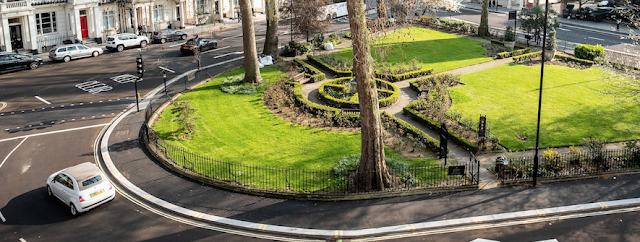




































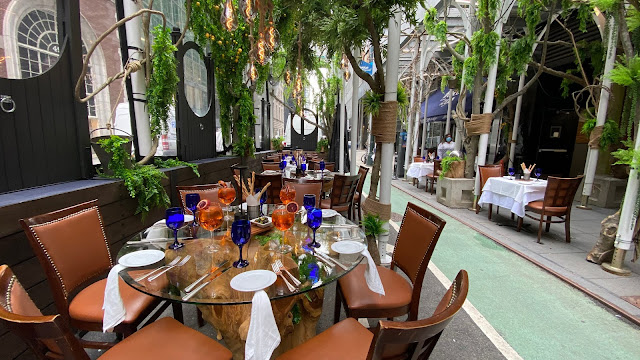









































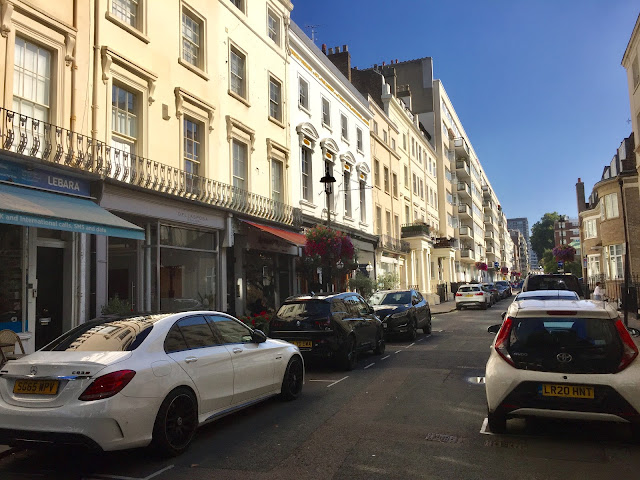












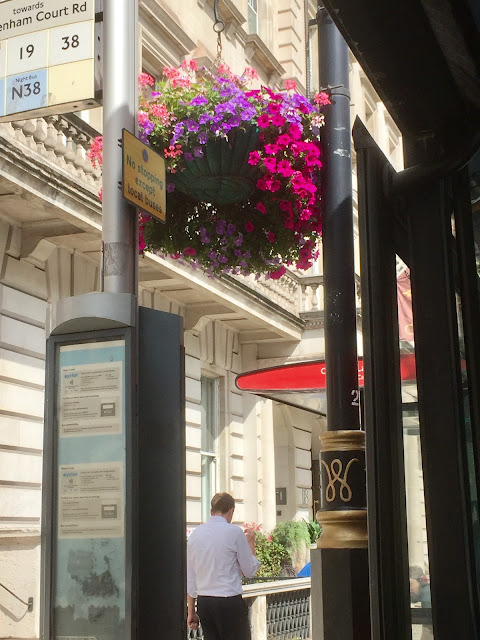





























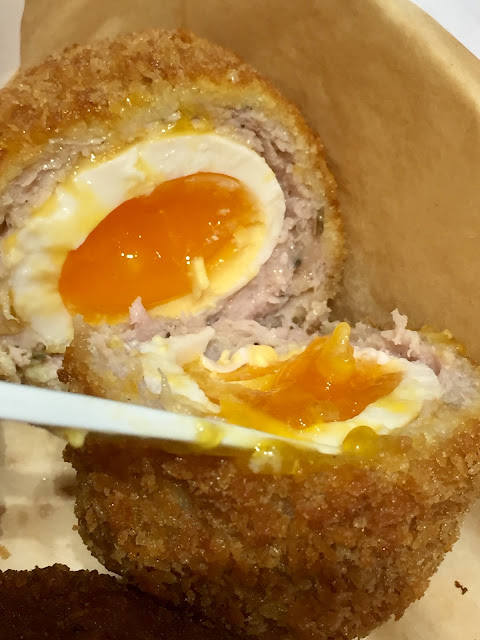












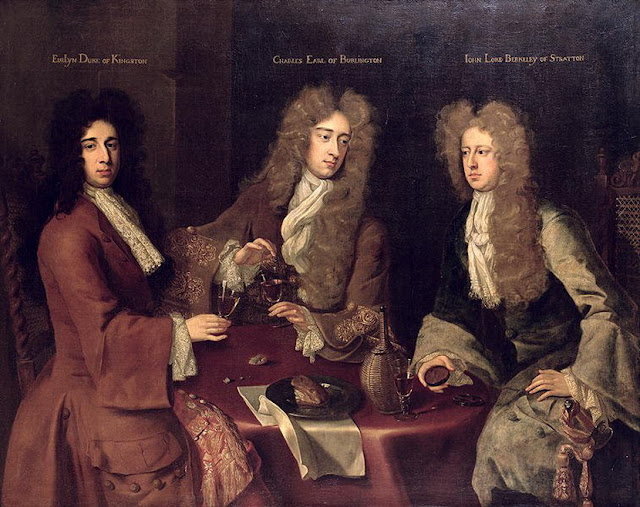




















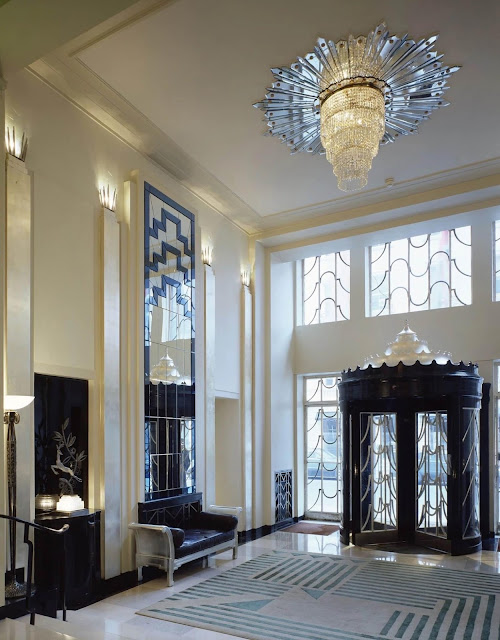











































_logo.png)














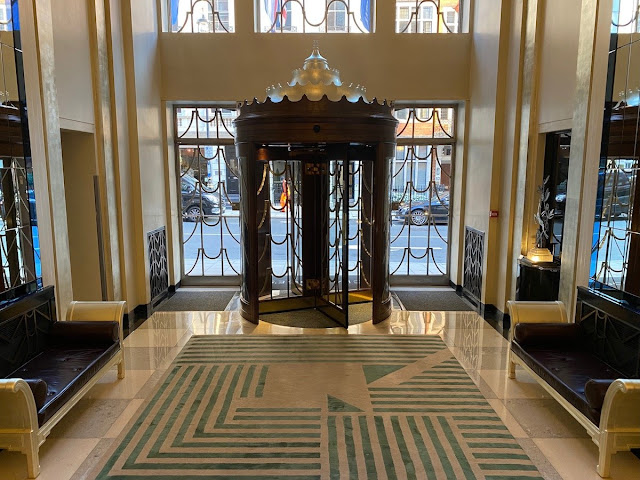
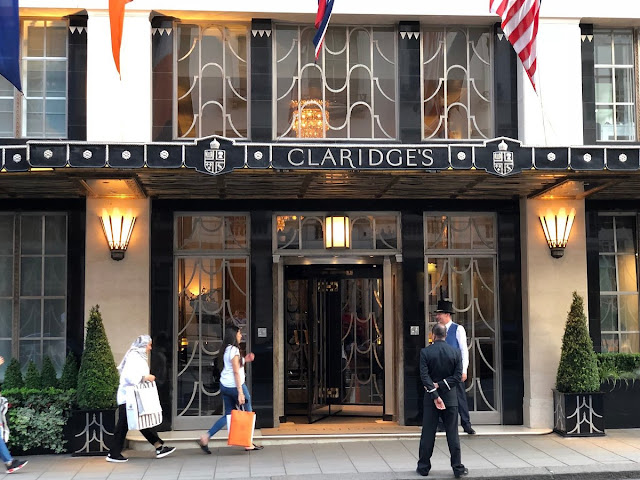




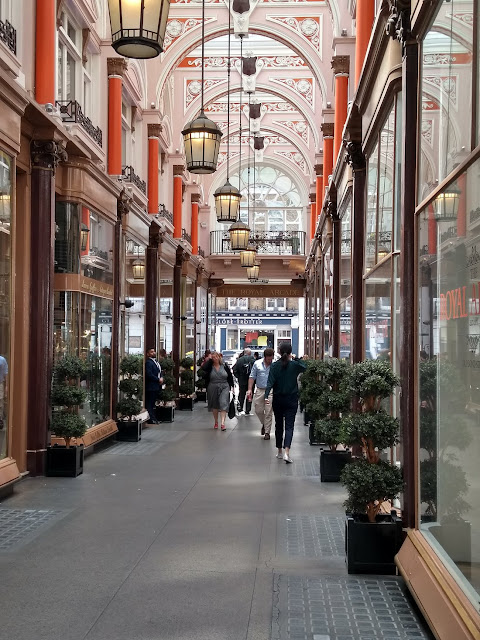

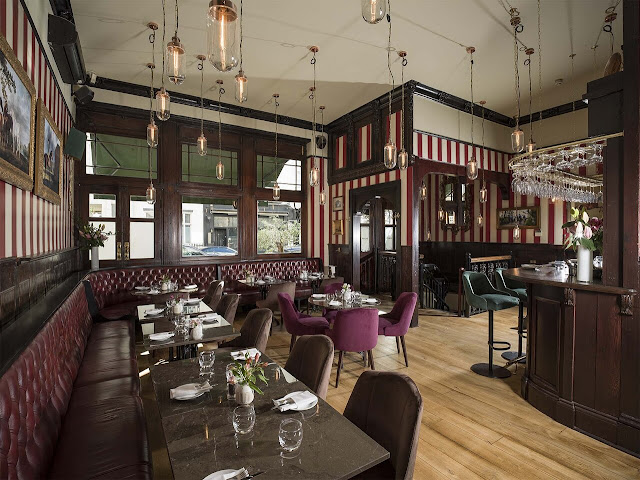


























No comments:
Post a Comment
Don't be shy: leave your comments :)